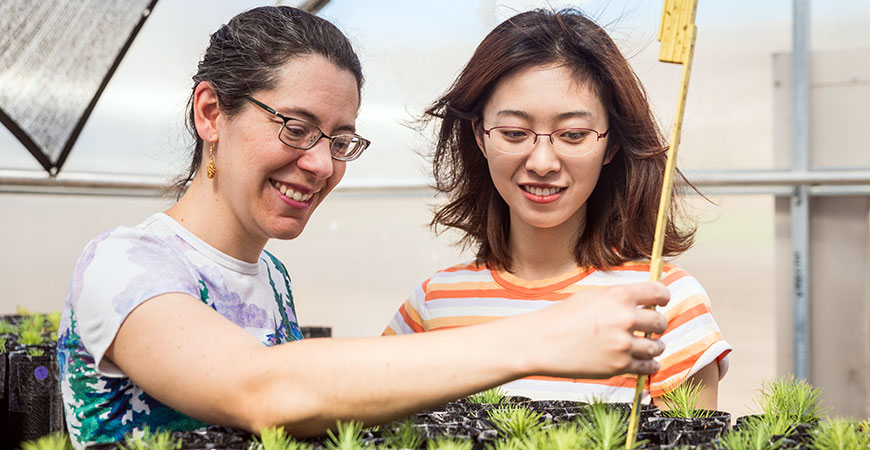
Wildfire seasons are intensifying because of climate change. That means reforestation efforts will increase, making it important for scientists and resource managers to understand how to make sure restorations will thrive in the future.
Because changes in climate challenge forests’ stability and productivity, forest ecology and genetics Professor Emily Moran and United States Department of Agriculture (USDA) Forest Service Research Geneticist Jessica Wright, with the Pacific Southwest Research Station, are studying how organisms have adapted to their past environments so they can find the best sources for seeds to replant.
They want to know whether specific genetic variations associated with different home climates, or the home climates themselves, can better predict which pine tree seedlings are more likely to thrive when planted as part of post-fire forest restoration.
“The point is to understand how we can identify the seed sources that will do well in the future, as the climate continues to warm,” Moran said. “Is it better to use non-local trees from a climate that in the past was similar to the planting site now or in the future, or more local trees that have genetic variants predicted to do well in the future climate?”
“When a site has had a really big fire, you have nothing left — no adult trees to throw off seeds. Without any shade from adult trees, increases in temperature can be intensified. Just because a particular species or genotype survived there before a fire doesn’t mean it will afterward.”
The two researchers had both been independently conducting projects with seeds from the USDA Forest Service’s Chico Seed Orchard. The orchard contains genotypes of trees sourced from throughout the Sierra Nevada that come from different home climates.
Moran, who is affiliated with the Sierra Nevada Research Institute, and Wright connected the two projects and recently received a $200,000, two-year seed grant from the USDA’s Agriculture and Food Research Initiative focusing on ponderosa pine. The Forest Service, interested in genome-informed seed transfer, has given the researchers an additional $50,000 to conduct similar work on sugar pines.
“Most of the USDA reforestation efforts in California focus on ponderosa and sugar pines, both of which are important economically and ecologically, and have been particularly impacted by drought, beetles and fire,” Wright explained. “Understanding natural genetic variation and selecting the most appropriate, best adapted seed stock will result in more successful reforestation projects.”
The project builds on work done by Mengjun Shu, a graduate student in Moran’s lab looking at the genetic characteristics of trees associated with variation in temperature and moisture.
“We showed there was a strong association between genetic variation and the climate of origin for a number of climate variables,” Shu said. “I’m excited to see how my research can help inform reforestation projects in California.”
Over the next two years, Wright and Moran will work at the site of the 2014 King Fire, which burned 97,000 acres in El Dorado County. Reforestation efforts began there in 2017. As part of this reforestation effort, Wright's team planted seedlings not just of local genotypes, but also seedlings from other elevation bands with different source climates.
“When a site has had a really big fire, you have nothing left — no adult trees to throw off seeds,” Moran said. “Without any shade from adult trees, increases in temperature can be intensified. Just because a particular species or genotype survived there before a fire doesn’t mean it will afterward.”
But trees that have genetic adaptations to other climates might. Moran and Wright are testing if genetic information can help optimize the design of seed lots for reforestation projects.
The grant supports two UC Merced undergraduate students, Roxana Khalili and Veronica Magana-Buie, to work with Wright in July and August to gather data from the site, including monitoring seedling growth and collecting pine needles for DNA extraction. Moran said this is a good opportunity for the students to conduct research in a safe manner during the COVID-19 pandemic.
“Out in the field, you’re outside, and usually standing some distance apart anyway,” she said. “The Forest Service is taking a lot of precautions as well — for instance, they will be self-quarantining away from the local community for two weeks at the start of the fieldwork. It takes a little more planning, but it is good that we will be able to continue this research and that the students don't have to miss out on this experience.”
Lorena Anderson

Senior Writer and Public Information Representative
Office: (209) 228-4406
Mobile: (209) 201-6255






